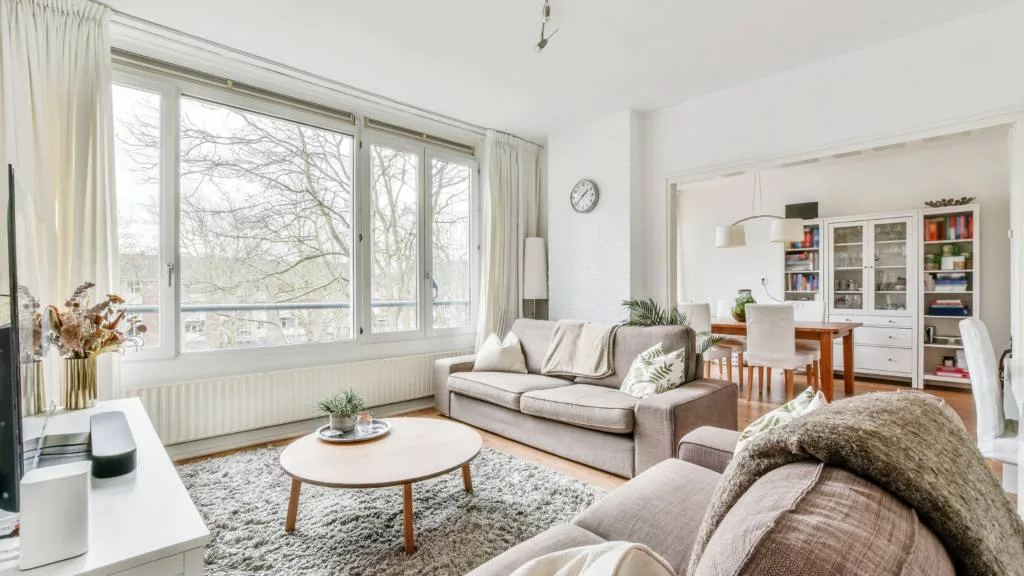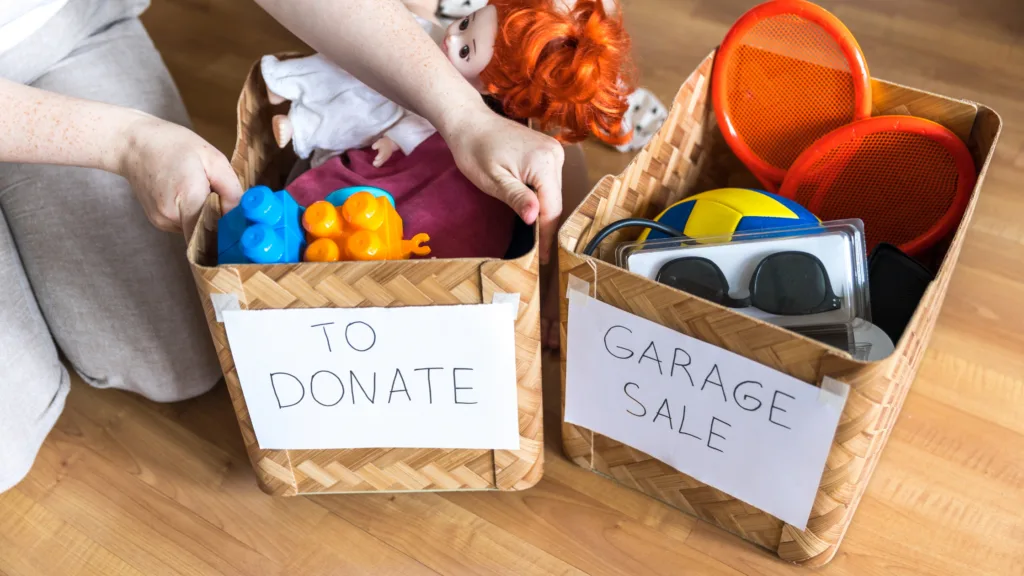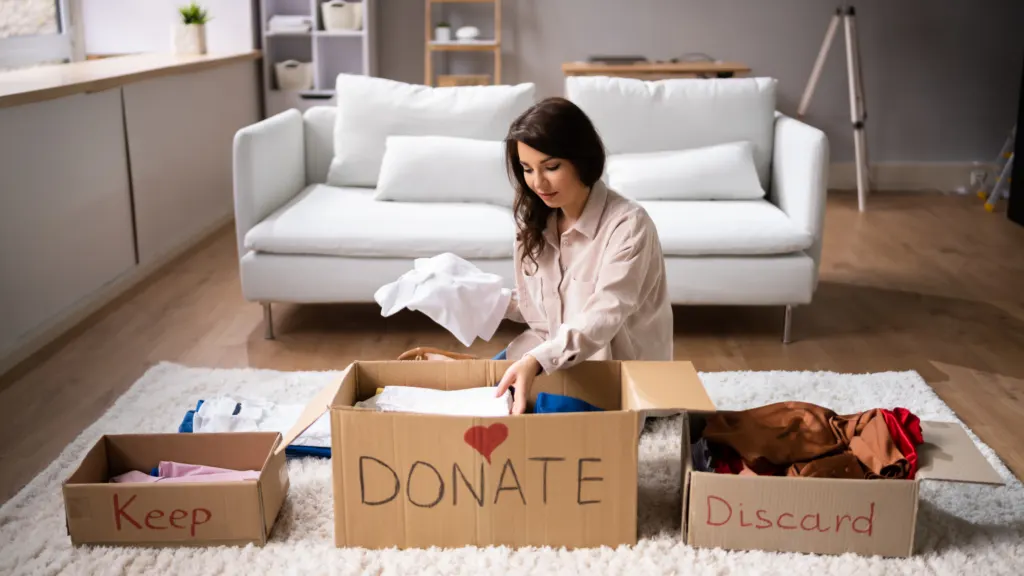The spring season brings a fresh start, not just for nature but for our living spaces. It’s the perfect time for homeowners and minimalists to tackle the timeless art of decluttering.
It’s the time most of us start to see the sun again, and with that sunshine comes much motivation. Since it’s been a long winter, let’s declutter purposefully without spending much money.
If you are like us this year, we are all about saving more than we spend. Keeping up with our budget every month is crucial to achieving those financial goals.
So let’s get to a list of how to declutter your home on a budget.

Declutter your home on a budget: It’s More Than a Clean Sweep
I often heard the “there’s more to life than things” speech growing up. As an adult, I found out it’s not just a platitude; it’s wisdom that keeps homes—and minds—sane.
The spring season is the ideal time to reset and simplify, and with these zero-cost strategies, you won’t just be cleaning the house; you’ll also be cleaning up your mental space.
Benefits Beyond a Tidy Home
Decluttering can do wonders for your stress levels. It’s like a weight off your shoulders when you realize you don’t actually need three spatulas or those jeans you haven’t worn in three years.
But the satisfaction doesn’t stop there; decluttering can also help you unearth creativity, improve concentration, and even save you money.
Studies show that living in an organized space reduces stress and improves eating and exercise habits.

Start with the Small Wins: The Kitchen
Our journey begins in the kitchen, the heart of the home. It’s often the first place we dump things without a clear home, so it can quickly become a hotspot for clutter.
Let’s attack this area with a “use it or lose it” mentality.
Step one to decluttering your kitchen: a thorough pantry and fridge cleanse. Not only will it make room for healthier food options, but you’ll also save money by not buying duplicates of things you already have.
As I dug through my own pantry, I found half-used bags of rice, beans, and pasta that I could easily incorporate into meals instead of buying new ingredients. Plus, the more organized your kitchen is, the easier it will be to find what you need and save time during meal prep.
Here are some tips for going through your fridge.
- Start by taking everything out and giving the shelves a good wipe-down. This will help you see what you have and what needs to be thrown away.
- Check expiration dates on all items and toss anything past its prime.
- Group similar items together, like condiments or dairy products, for easier organization.
- Consider investing in some storage containers or bins to keep things neat and easily accessible.
- Be mindful of overstocking your fridge – only buy what you know you will use to avoid food waste.
Now, let’s tackle the dreaded kitchen junk drawer. We all have one (or maybe more!) and it’s usually a black hole for random items.
Start by dumping everything out and sorting through it. Throw away anything that is broken or no longer useful.
Then, designate specific sections in the drawer for different items, such as office supplies, batteries, and miscellaneous tools. Use small containers or dividers to keep everything organized.
Let’s not forget the kitchen cabinets. Do you need 20 plastic plates? Here are some tips for decluttering your kitchen cabinets.
- Take everything out of the cabinets and wipe down the shelves.
- Get rid of any items that are broken, chipped, or no longer needed.
- Group similar items together, like glasses, plates, and bowls.
- Consider donating excess or duplicate items to a local charity or thrift store.
- Utilize storage solutions such as shelf risers or hanging racks to maximize space.

Revamp the Living Room: Where Relaxation Meets Rummage
Your living room is the face you present to the world (well, your guests, at least). So, let’s make sure it’s putting your best-cluttered foot forward. Without fancy storage systems, how can we keep the harmony—especially if it multi-tasks as a playroom, study hall, and pet sanctuary?
Step one to decluttering your living room. Use your 20/20 vision to scope out any items that are broken, damaged, or no longer being used. If it’s not serving a purpose or bringing you joy, it’s time to say goodbye.
Start grouping similar items together – books with books, toys with toys, etc. This will help create a sense of order and make finding things easier in the future. Also, consider using storage solutions like baskets or bins to corral smaller items and keep them out of sight.
Don’t be afraid to let your living room serve multiple purposes – just ensure everything has a designated spot. If you use it as a study hall, have a designated area for books and school supplies.
Designate a corner for their toys and bed if it’s also your pet sanctuary. Position furniture for flow and room to breathe. These layout modifications alone can make your space feel refreshingly new.
Remember, decluttering doesn’t have to be perfect. Embrace the imperfection and focus on creating a functional and comfortable space for yourself and your family.

Bedrooms: Decluttering Makes These Spaces Breathe
Where’s the one place that should always be a sanctuary? Your bedroom. Yet, it often doubles as an impromptu storage area. Let’s explore how we can keep your sleeping space serene without a costly Marie Kondo consultation.
The Clothing Crisis
Let’s start by tackling your closet. Is it bursting at the seams with clothes you haven’t worn since that one event five years ago? Or maybe it’s your dresser, overflowing with socks and underwear because you can never find what you need.
It’s time to declutter and organize your clothing so that getting dressed in the morning is a stress-free experience.
Step one: Take everything out of your closet and dresser. Yes, everything. This may seem daunting, but trust me, it’s worth it.
Step two: Sort through each item one by one and ask yourself when was the last time you wore it? If it’s been over a year, or if you can’t even remember the last time you wore it, then it’s time to say goodbye. For items with sentimental value, consider taking a photo and keeping the memory instead of the physical item.
Step three: Group similar items together, such as all your jeans or t-shirts. This will make it easier to see what you have and avoid buying duplicates.
Step four: Invest in some storage solutions, such as hanging shelves or under-bed storage containers, to maximize your space.
Step five: As you put items back in your closet and dresser, make sure to keep them organized by type or color. This will not only make it easier to find things but also create a visually appealing and calming space.
With a decluttered and organized closet, getting dressed in the morning will be a breeze. You’ll no longer have to sift through piles of clothes or struggle to find a matching pair of socks.
And the best part? You didn’t need to spend money on an expensive Marie Kondo consultation. A clutter-free wardrobe can be achieved with just a little time and effort. T

Bathrooms: Clear Shelves, Clear Skin
Surprisingly, the bathroom can be host to a cornucopia of clutter. Mini shampoo bottles from hotels, expired prescriptions, rarely-used hair tools—they gather dust and create visual noise.
Step one: Remove everything from your shower and wipe down the shelves.
Step two: Start by taking a photo of your bathroom before you begin decluttering. This will serve as a reminder of what not to bring back into the space. Next, group similar items together, such as skincare products or hair tools. This will make it easier to see what you have and avoid buying duplicates.
Step three: Invest in some shower caddy organizers if you need to from the Dollar Tree to keep your products neatly in place. You can also use a hanging shoe organizer on the back of your bathroom door to store larger items like towels and toiletries.
As I was cleaning out my own bathroom, I couldn’t believe how much clutter had accumulated over time. I had expired medications, half-used bottles of shampoo, and random hair accessories that I had never used. It was overwhelming at first, but as I started decluttering and letting go of things I didn’t need, I felt a sense of relief.
One major tip is to check the expiration dates on all your products. It’s time to say goodbye if anything is over six months old. Trust me, you don’t want to risk using expired products on your skin or hair.

Garage to Glory: Redemption of the Clutter Catch-All
How should we start organizing the garage? First, let’s take a deep breath and mentally prepare to tackle this overwhelming project.
Now, start by taking everything out of the garage and sorting it into categories: keep, donate, and trash. Be ruthless in your decisions; if you haven’t used something in over a year, you won’t miss it.
Next comes the challenging part—finding designated spaces for each category. Shelving units, labeled containers, and wall-mounted racks are all excellent storage solutions.
And don’t forget about vertical space! Install ceiling hooks or a pulley system to store larger items like bikes or kayaks. Remember, the goal is to keep everything off the floor to maximize space and prevent clutter buildup in the future.
Repurposing and Upcycling: Making Old New Again
The joy of spring cleaning unplugged comes from the opportunity to look at things differently. That bookshelf could be a shoe rack.
Those glass jars could house your homemade candles. Get ready to see your home and your belongings in a new light.
Here are some examples of ways you can repurpose common household items into something new and fresh.
Old T-Shirts into Cleaning Rags
Instead of throwing out old t-shirts, cut them up into cleaning rags. They are soft and absorbent, perfect for dusting or wiping down surfaces.
Mason Jars as Storage Containers
Mason jars are not only great for canning food but also for storing small items in the garage. Use them to hold nails, screws, or other hardware.
Wooden Crates as Shelves
If you have some old wooden crates lying around, don’t throw them out! They can be easily turned into shelves by adding a coat of paint and mounting them on the wall.
Tubular Tool Storage
Those old plastic tubs can be repurposed into convenient gardening or DIY tools storage. Simply drill some holes in the sides and bottom, and hang them on hooks on a shed wall.
Shoe Organizer for Cleaning Supplies
Hang a shoe organizer on the back of your cleaning supplies closet door and use it to store sponges, scrub brushes, and other cleaning tools. This will free up space in your cabinet and make it easier to find what you need.
Picture Frames as Trays
Don’t toss out that old picture frame just yet. You can turn it into a chic tray by adding some decorative paper or fabric to the inside. Use it to display candles and books or as a catch-all for keys and other small items.
There are so many ideas on Pinterest too.

Donations and Sales: Pass It On or Pocket Some Cash
Once you’ve sifted through your belongings, it’s time to let go. But before it goes in the trash, consider how your clutter could be someone else’s essential item—often, all it takes is a local charity or community marketplace.
Consider selling your clothing items to stores like Plato’s Closet, or if you have a lot of clothes and don’t have a store near you to resell, consider online thrift stores to send your clothes to, like Thredup.
So, instead of throwing it away, pass it on to someone who needs it or sell it for extra cash. You’ll be helping others and decluttering at the same time.
Low-Cost Solutions for Long-Term Order
Decluttering isn’t a once-a-year marathon; it’s a lifestyle. Look around your home to find things that you already have.
It’s amazing what can be repurposed for storage solutions. Old shoe boxes, mason jars, and even egg cartons can all become useful containers for organizing your space.
Some low-cost solutions for maintaining organization in your home could include:
- Utilizing containers and bins you already have: Rather than buying expensive organizers, try repurposing old shoeboxes or plastic containers to store items.
- Labeling items: This can help keep things organized and easy to find, especially for children who may not know where things belong.
- Creating a designated space for items: Designate specific areas or shelves for different categories of items, such as books, toys, or kitchen supplies.
- Using hooks and racks: These can be inexpensive options for hanging coats, bags, and other frequently used items.
- DIY projects: Get creative and make your own organization solutions using materials you already have at home. For example, turn an old ladder into a bookshelf or use mason jars to store small items.
Remember, the key is to find solutions that work for you and your space without breaking the bank. Maintaining an organization can be easy and affordable with a little creativity and resourcefulness. So let’s start incorporating these hacks into our daily lives and keep clutter at bay for
Spark the Joy of a Clutter-Free Existence
Spring cleaning on a budget does not mean we’re cutting corners. Spending less and living more is a deliberate choice, casting off the unneeded to make room for the essential.
By approaching our living spaces with a frugal mindset, we can escape the accumulation cycle and learn to appreciate what we have truly.
Decluttering becomes more than just a seasonal chore—it’s a celebration of resourcefulness, a practice in creative living, and a testament to the incredible things we can do without spending a dime.
Let’s open the windows, let the light in, and welcome the simplicity of a home that breathes.
